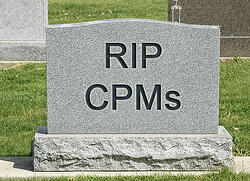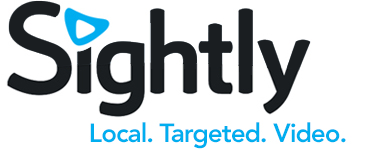A Measure of Quantity, not Quality
A CPM is a media measure that values the cost-per-mille (or cost-per-thousand impressions) for an ad campaign buy.
It’s a legacy from radio and TV advertising. Networks estimated the size of their audiences so they could calculate how many times ads were exposed to listeners and viewers (impressions) and place a dollar value on that number (CPMs).
 The challenge was they had no way to determine the quality of impressions. Even today, when a network or station runs a TV commercial, no one really knows for certain how many people actually watch it, or whether they are viewers that the advertiser really wants to target. Still, CPMs remain the primary units for selling and buying TV and radio.
The challenge was they had no way to determine the quality of impressions. Even today, when a network or station runs a TV commercial, no one really knows for certain how many people actually watch it, or whether they are viewers that the advertiser really wants to target. Still, CPMs remain the primary units for selling and buying TV and radio.
A whole new view
As digital media have evolved (initially, online display but more recently, video), they have followed in the footsteps of traditional media in using impressions and CPMs for selling ads. Most brands and agencies today buy display and video ads on a CPM basis.
However, ad technology companies have been steadily innovating more precise ways to measure the size and character of ad audiences, as well as their engagement with ads. And this insight has prompted a new focus on a much more valuable metric—the view.
The good news for video advertisers is that, in time, most of the digital media market will trade on the true value of a video campaign: how many and which specific people watch your entire ad.
The hot-hot-hot button
Viewability has become the hot-hot-hot button issue of the day as brands and agency media planners are realizing just how many of the display and video ad CPMs they pay for are never seen.
Many video ad publishers and networks built their systems on legacy display ad technology and in many cases, it can’t distinguish between user-initiated and forced-view video ads, tagging both as impressions.
How bad is it? Integral Ad Science reported that in Q4 2014, viewers never saw 61% of the video ads brands and agency media planners bought.1
Keep in mind this statistic excludes the Google/YouTube ecosystem, which operates differently than the rest of the video ad industry.
A clear and better alternative
In December, 2010, YouTube introduced its skipable ad format called TrueView, along with a different value model than CPMs.
The new media measure called “CPV” values the cost-per-view for a skipable video ad campaign. This model charges advertisers only when a viewer chooses to watch a full ad, or 30 seconds, whichever is shorter.
Writing in Ad Age at the time, Baljeet Singh explained why YouTube defined TrueView this way:
“Viewer intention to watch an ad is widely seen as a proxy for whether a brand message is being delivered and consumed.”2
 Indeed, YouTube ad revenue has climbed steadily since then, surpassing cable networks like AMC and ESPN ad revenues, and approaching the traditional broadcast networks like NBC and CBS.
Indeed, YouTube ad revenue has climbed steadily since then, surpassing cable networks like AMC and ESPN ad revenues, and approaching the traditional broadcast networks like NBC and CBS.
The Full Value of the View
Buying media on a cost-per-view basis produces tremendous value for brand stewards both in terms of engagement and bang for the buck.
At Sightly, our platform optimizes campaigns to maximize views at the most cost effective CPV. The major benefits of this approach are:
- 100% of the ad spend generates full views. In other words, every ad spend dollar goes toward delivering the most relevant, highest quality video advertising engagements possible—micro-targeted viewers who choose to watch your message.
 As significant added value, we also tell you how many free partial views your campaigns produce. Remember, at a minimum, every targeted viewer watches your ad for five full seconds before they can choose to skip. That’s 33% of a 15-second spot and 17% of a :30. And when you total up the dollar value of those partial views, it's often equal to or greather than the ad spend, effectively doubling your ROI.
As significant added value, we also tell you how many free partial views your campaigns produce. Remember, at a minimum, every targeted viewer watches your ad for five full seconds before they can choose to skip. That’s 33% of a 15-second spot and 17% of a :30. And when you total up the dollar value of those partial views, it's often equal to or greather than the ad spend, effectively doubling your ROI.- Because we target pre-roll in stream inventory first and foremost, we deliver premium engagements, where the ad unit is nearly 100% viewable, far exceeding industry standards. And, because we personalize your ads for each audience and location, the overall effect is eye-opening.
There are some other platforms outside YouTube that provide “completed view” metrics. Ads in those campaigns are typically of the forced-view, 15-second variety. While these ads certainly deliver value to the advertiser, the engagements aren’t comparable to skipable ads, where the viewer chooses to watch the entire ad regardless of its length.
As advertisers learn more about the high-value CPV video ad alternative, and media planners learn about frictionless systems like Sightly’s platform for managing CPV campaigns, the day isn’t far off when CPMs are laid to rest.
If you'd like a shareable PDF copy of this article, just select this button:
Notes: 1 Integral Ad Science, “2014 Media Quality Report.” 2 “Why Video Advertising Needs to Dump Impressions and Move to 'Cost Per View',” Ad Age, March 1, 2011


